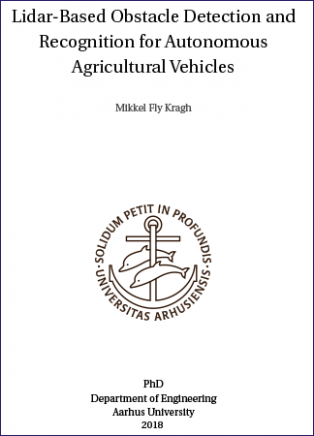Lidar-based Obstacle Detection and Recognition for Autonomous Agricultural Vehicles
Keywords:
lidar, point cloud, classification, sensor fusion, calibration, registration, synchronization, localization and mapping, precision agriculture, computer vision, convolutional neural networkSynopsis
Today, agricultural vehicles are available that can drive autonomously and follow exact route plans more precisely than human operators. Combined with advancements in precision agriculture, autonomous agricultural robots can reduce manual labor, improve workflow, and optimize yield. However, as of today, human operators are still required for monitoring the environment and acting upon potential obstacles in front of the vehicle. To eliminate this need, safety must be ensured by accurate and reliable obstacle detection and avoidance systems.
In this thesis, lidar-based obstacle detection and recognition in agricultural environments has been investigated. A rotating multi-beam lidar generating 3D point clouds was used for point-wise classification of agricultural scenes, while multi-modal fusion with cameras and radar was used to increase performance and robustness. Two research perception platforms were presented and used for data acquisition. The proposed methods were all evaluated on recorded datasets that represented a wide range of realistic agricultural environments and included both static and dynamic obstacles.
For 3D point cloud classification, two methods were proposed for handling density variations during feature extraction. One method outperformed a frequently used generic 3D feature descriptor, whereas the other method showed promising preliminary results using deep learning on 2D range images. For multi-modal fusion, four methods were proposed for combining lidar with color camera, thermal camera, and radar. Gradual improvements in classification accuracy were seen, as spatial, temporal, and multi-modal relationships were introduced in the models. Finally, occupancy grid mapping was used to fuse and map detections globally, and runtime obstacle detection was applied on mapped detections along the vehicle path, thus simulating an actual traversal.
The proposed methods serve as a first step towards full autonomy for agricultural vehicles. The study has thus shown that recent advancements in autonomous driving can be transferred to the agricultural domain, when accurate distinctions are made between obstacles and processable vegetation. Future research in the domain has further been facilitated with the release of the multi-modal obstacle dataset, FieldSAFE.

